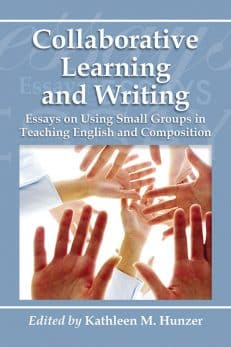Collaborative Learning and Writing
Essays on Using Small Groups in Teaching English and Composition
$49.95
In stock
About the Book
Although most writing instructors know the benefits of collaborative learning and writing in college writing classes, many remain unsure how to implement collaborative techniques successfully in the classroom. This collection provides a diversity of voices that address the “how tos” of collaborative learning and writing by addressing key concerns about the process. Fresh essays consider the importance of collaborative work and peer review, the best ways to select groups in classes, integration of collaborative learning techniques into electronic environments, whether group learning and writing are appropriate for all writing classes, and ways special populations can benefit from collaborative activities. Despite its challenges, collaborative learning can prove remarkably effective and this study provides the advice to make it work smoothly and successfully.
Instructors considering this book for use in a course may request an examination copy here.
About the Author(s)
Bibliographic Details
Edited by Kathleen M. Hunzer
Format: softcover (7 x 10)
Pages: 236
Bibliographic Info: figures, bibliography, index
Copyright Date: 2012
pISBN: 978-0-7864-6029-8
eISBN: 978-0-7864-8977-0
Imprint: McFarland
Table of Contents
Acknowledgments iv
Preface KATHLEEN M. HUNZER 1
Part I: Why are collaborative learning and peer review important?
Writing Courses Live and Die by the Quality of Peer Review JASON WIRTZ 5
Bringing New Perspectives to a Common Practice: A Plan for Peer Review ANTHONY EDGINGTON 17
Reinventing Peer Review Using Writing Center Techniques: Teaching Students to Use Peer-Tutorial Methodology CATHERINE SIMPSON KALISH,
JENNIFER L. J. HEINERT, and VALERIE MURRENUS PILMAIER 30
“It’s just too nicey-nicey around here”: Teaching Dissensus in Research and Collaborative Groups JACOB STRATMAN 43
Part II: How do I best select groups in my classes?
Increasing Student Participation and Accountability in Group Production of Text through Speed Interviews MIALISA A. MOLINE 55
Connecting Writing Process with Personality: Creating Long-Lasting Trust Circles in Writing Classes KATHLEEN M. HUNZER 66
Forming Peer Critique Groups Through Personality Preferences MIALISA A. MOLINE 75
Part III: How do I integrate collaborative learning techniques into electronic environments?
Collaborative Learning and Writing in Digital Environments CINDY TEKOBBE, YAZMIN LAZCANO-PRY, and DUANE ROEN 87
Keeping Up with the Future: Using Technology to Facilitate Small-Group Collaboration in the Writing Classroom KELLY A. SHEA 99
Cooperative and Collaborative Writing with Google Docs DONNA J. EVANS and BEN S. BUNTING, JR. 109
Working with Groups Online: Collaborating with Web Conferencing CHERYL HAWKINSON MELKUN 130
Part IV: Can collaborative learning and writing work in all writing classes?
Blending Collaboration and Competition: A Model for Small Group Learning in Business Writing Classes RANDI BROWNING 143
Revisiting Collaborative Writing and Electronic Dialogues in Business Communication FLORENCE ELIZABETH BACABAC 166
Collaborative Composing: Practices and Strategies for Implementing Team Projects into Writing Classrooms KARA POE ALEXANDER 181
Part V: Can special populations benefit from collaborative activities?
Working Together Towards Greatness: The Cumulative Writing Model and English Language Learners ROBB MARK MCCOLLUM 201
Anxiety Disorders and the Collaborative Classroom KATHLEEN M. HUNZER 217
About the Contributors 225
Index 229
Book Reviews & Awards
“Helps instructors incorporate effective collaborative learning into their writing classes”—Reference & Research Book News.





